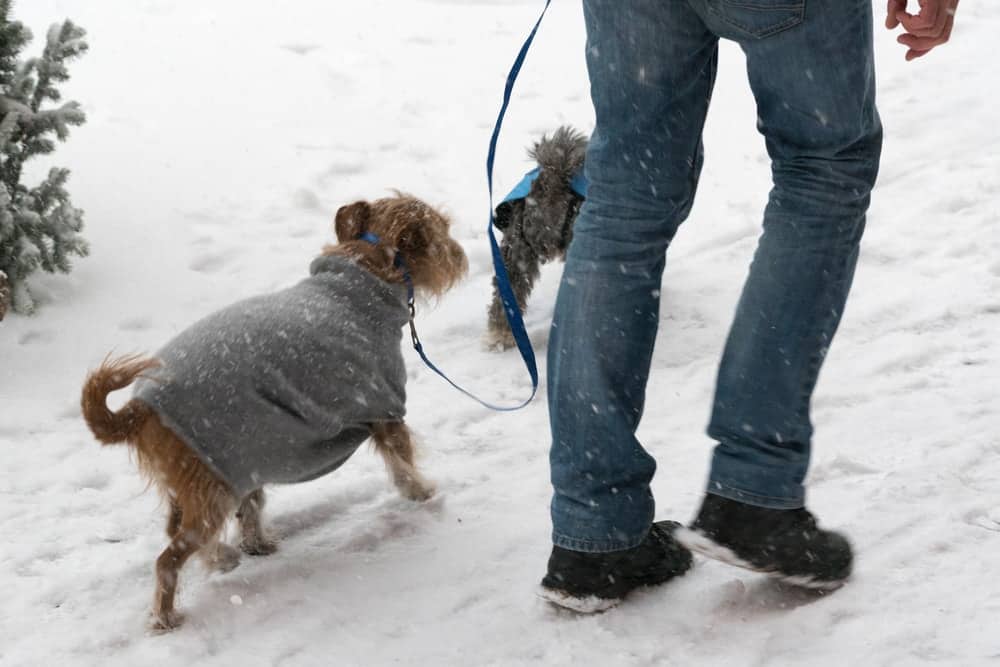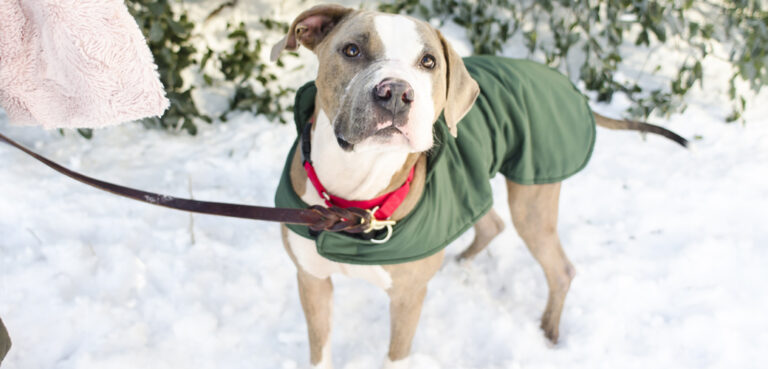It is too cold to walk your dog when the temperature drops below 20°F (-7°C). Walking your dog in extremely cold weather can lead to frostbite and hypothermia.
When winter sets in, it’s crucial to consider your furry friend’s safety and well-being during outdoor activities. Dogs may not be able to communicate their discomfort in the cold, making it essential for owners to gauge the weather and understand the signs of when it’s too cold for a walk.
Assess the temperature, wind chill, and your dog’s breed and coat type to determine if it’s safe to venture outdoors. While exercise is important for dogs, extreme cold can pose serious health risks. Understanding the thresholds for cold weather will help ensure your dog stays happy and healthy throughout the winter months.

Credit: www.dogingtonpost.com
Signs It’s Too Chilly For Canine Walks
When the temperature drops, it’s important to keep an eye on your furry friend’s behavior for signs of discomfort. Some indicators that it’s too cold for dog walks include shivering and whining, a hunched posture with a tucked tail, anxious behavior, reluctance to continue walking, and weakness or lethargy. If you notice any of these symptoms, it’s best to bring your pup indoors and opt for indoor activities until the weather improves. Always prioritize your pet’s well-being and make adjustments to their exercise routine as needed based on the weather conditions.
Dog Breed And Cold Tolerance
Some dog breeds can handle the cold better than others. Pay attention to your dog’s behavior when the temperature drops. On particularly chilly days, consider keeping your walks shorter or opting for indoor play instead. It’s essential to monitor your dog’s comfort and health in colder weather.
When considering walking your dog in cold weather, it’s important to understand their breed’s cold tolerance. Small breeds tend to have less body fat and a thinner coat, making them more susceptible to the cold. On the other hand, larger breeds with a thicker coat and higher body fat levels may tolerate colder temperatures better. Additionally, age and health play a crucial role. Senior dogs and those with health issues may struggle in colder weather. It’s essential to observe your dog’s behavior and signs of discomfort during walks in cold weather. Adjust the duration and intensity of walks to ensure your dog’s well-being. Always consider using protective clothing for your pet in extreme cold. Regular veterinary check-ups can help evaluate your dog’s ability to tolerate the cold and provide appropriate recommendations.Checking The Temperature And Wind Chill
When taking your dog for a walk, it’s crucial to consider the temperature and wind chill. Ideal temperature ranges for dog walks vary based on the breed and size of your dog. Interpreting the wind chill factor is essential to understand how the temperature feels to your dog’s sensitive paws and skin. Weather apps provide accurate forecasts, allowing you to plan your dog walks effectively. By understanding these factors, you can ensure the safety and well-being of your furry friend.
Planning Shorter Walks
During colder weather, it’s important to adjust the duration of your dog’s walks. For shorter walks, consider spending 10-15 minutes outdoors to prevent your dog from getting too cold. If the temperatures are very low, it’s best to limit the walk time even more to ensure your dog’s safety and wellbeing. Regular, brief outings are crucial in colder weather, as they allow your dog to relieve themselves and get fresh air, while avoiding overexposure to the cold. Additionally, consider adapting exercise routines for indoor play. Engage your dog with interactive toys, hide and seek games, or indoor agility exercises to keep them active without exposing them to harsh weather conditions.
Dressing Your Dog Appropriately
When deciding when it is too cold to walk your dog, it is important to consider the appropriate clothing to protect them. Dog sweaters and jackets can provide warmth and insulation, helping to maintain their body temperature. Additionally, protective booties can shield their paws from salt and ice, preventing discomfort and potential injury. When choosing the right size and material for your dog’s attire, it is essential to ensure a proper fit and the ability to withstand the elements. By dressing your dog appropriately, you can ensure they stay comfortable and safe during cold weather walks.
Spotting And Preventing Frostbite And Hypothermia
Recognizing early symptoms: Keep an eye out for shivering, weakness, and slowing down during walks, as these could be initial signs of cold-related illness. If your dog is lifting their paws frequently or limping, it’s time to head indoors.
Immediate actions and seeking veterinary care: If you notice any of these symptoms, bring your dog indoors to warm up and contact your veterinarian immediately. Professional help is crucial for severe cases.
Preventative measures during walks: Be mindful of the temperature and wind chill before heading out. Utilize doggy boots and sweaters for added insulation. Also, limit exposure and consider shorter walks during extreme cold.
Adjusting Feeding And Hydration
Increased calorie needs in cold weather: As temperature drops, your dog may require more calories to maintain body warmth. In colder weather, consider adjusting their food intake to accommodate the additional energy requirements.
Importance of fresh water to prevent dehydration: Even in cold weather, it’s crucial to ensure your dog has access to fresh water. Dehydration can occur even when temperatures are low, so regularly check and refill water bowls to prevent this risk.
After-walk Care
After-Walk Care
When walking your dog in cold weather, it’s essential to ensure proper after-walk care to prevent any discomfort or health issues. Drying and warming your dog is crucial to prevent them from getting too cold. Pay special attention to their paws as well, as they are susceptible to salt and deicers. Establish paw care routines to remove any harmful substances and prevent irritation. Additionally, it’s important to monitor your dog for any signs of discomfort or distress, such as shivering or limping. Acting promptly can help in mitigating any potential issues and ensuring your dog’s well-being during the cold weather.
Frequently Asked Questions On When Is It Too Cold To Walk Your Dog
How Cold Is Too Cold To Walk Your Dog?
In general, if the temperature is below 20°F (-6°C) it’s probably too cold for your dog to be outside for a walk. Factors like your dog’s breed, size, and coat should also be considered. Always monitor your dog for signs of discomfort or distress when walking in cold weather.
What Are The Signs Of Cold Stress In Dogs?
Signs of cold stress in dogs include shivering, whining, anxiety, lifting of paws, reluctance to walk, and seeking warmth. Dogs with short coats or smaller breeds are more susceptible. If you notice any of these signs, it’s best to bring your dog indoors and warm them up.
Can You Protect Your Dog From The Cold During Walks?
You can protect your dog from the cold during walks by using a dog sweater or coat, and booties to protect their paws. Limit the time spent outside, and always monitor your dog for signs of discomfort. Keep your dog on a leash to prevent them from running too far ahead and getting lost.
Conclusion
In the end, it’s essential to prioritize your dog’s well-being in cold weather. Pay attention to their behavior and body language when you take them for a walk in chilly temperatures. Consider their breed, age, and health conditions to determine if it’s too cold for them.
Keep them warm and cozy to ensure their safety and comfort.



